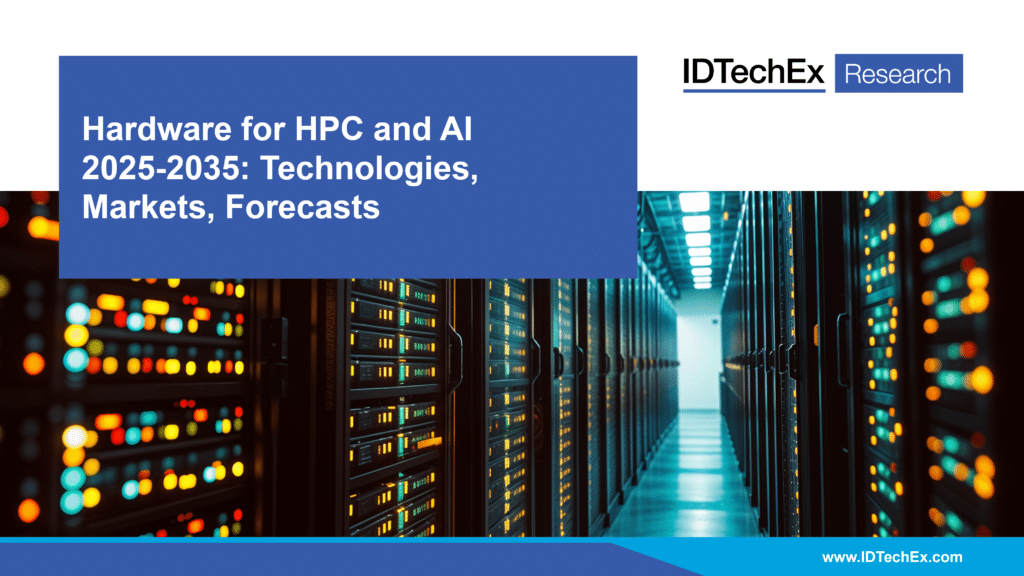For more information, visit https://www.idtechex.com/en/research-report/hardware-for-hpc-and-ai-2025-2035-technologies-markets-forecasts/1058.
HPC hardware market to reach US$581 billion by 2035 at a CAGR of 13.6%.
This report examines the high-performance computing (HPC) and AI hardware markets. It provides an overview of the overall HPC market in the exascale era, including analysis of major supercomputers like El Capitan. Detailed overview of technologies including GPUs and accelerators, CPUs, memory, advanced semiconductor packaging, interconnects, and thermal management is provided, alongside over 50 profiles of HPC industry players, many from primary interviews. Highly granular forecasts from 2025 to 2035 in volume and revenue for the overall HPC and AI hardware market and 6 key classes of hardware provide a picture of the evolving opportunities in this market, with a US$581 billion market value forecast by 2035.

HPC systems, including supercomputers, outclass all other classes of computing in terms of calculation speed by parallelizing processing over many processors. HPC has long been an integral tool across critical industries, from facilitating engineering modelling to predicting the weather. As both the use-cases of AI and machine learning have grown alongside the scale of their underlying models, the demand for HPC systems has only intensified, alongside the demands on their processing power and interconnects between computing nodes.
The largest HPC systems in the world, which can perform over 1 quintillion floating-point operations per second, are the preserve of government-operated national labs of global superpowers. However, private corporations are not far behind, with cloud providers like Microsoft Azure possessing supercomputers in the upper echelons of performance. Growth here is only expected to accelerate as the deployment of AI widens.
IDTechEx’s report examines the key hardware challenges in HPC, which revolve around processors, memory and storage, advanced packaging, interconnects, and thermal management. GPUs and other AI accelerators grab all the headlines in the processor space, with important trends including the adoption of cores for tensor processing within GPUs and hints of AMD challenging NVIDIA. However, substantial progress has also taken place in the CPU market, with core counts approaching 200 in chips like AMD’s Turin processors and the deployment of integrated heterogeneous systems – GPUs and CPUs integrated into the same package – taking place in the world’s most powerful supercomputers, including the USA’s El Capitan and China’s Tianhe-3.
In the memory space, the adoption of HBM (High Bandwidth Memory) has been crucial to the growing capabilities of accelerators, with approximately 95% of accelerators in HPC now employing the technology, but research into next-generation memory technologies such as selector-only memory (SOM), phase change memory (PCRAM) and magnetoresistive RAM (MRAM) is being driven by the high energy consumption of today’s memory choices. The quest for high-capacity storage that meets the increasing performance requirements of HPC workloads is seeing the emergence of high-density QLC SSDs at a lower cost-point than typical TLC SSDs available in the market.
Advanced packaging is a key enabler of all these chip technologies, with the 3D stacking of memory on top of logic being the best approach to achieve ultra-high bandwidths by shrinking on-device interconnect distances. Advanced packaging techniques are also highly important for the roadmaps of the interconnects between HPC nodes, as future iterations of low-latency networks like NVIDIA’s InfiniBand and HPE’s Slingshot move towards co-packaged optics to further reduce the distances data must travel at the chip scale and speed up throughput overall.
Of course, these advances evolve large amounts of heat, so thermal management performance is key. Despite immersion cooling’s strong performance in operational expense and performance, cold plate cooling is expected to remain the technology of choice in most cases as HPC builders seek to reduce the massive capital expenses that come with building these enormous interconnected machines.

For those needing to understand the HPC market, including the above trends and further challenges like the development of storage and the geopolitical dynamics that have affected the growth of this technology, IDTechEx’s report is a must. At the dawn of the exascale era and in the most fruitful period for AI development yet, the demand for supercomputing is set for rapid expansion. As such, Hardware for HPC and AI 2025-2035 includes 10-year forecasts not only for the overall HPC hardware market, but for key hardware technologies including CPUs, GPUs, memory including HBM, storage and server boards. The reader will leave equipped with a wide-ranging, in-depth picture of the present and future of this exciting industry.


